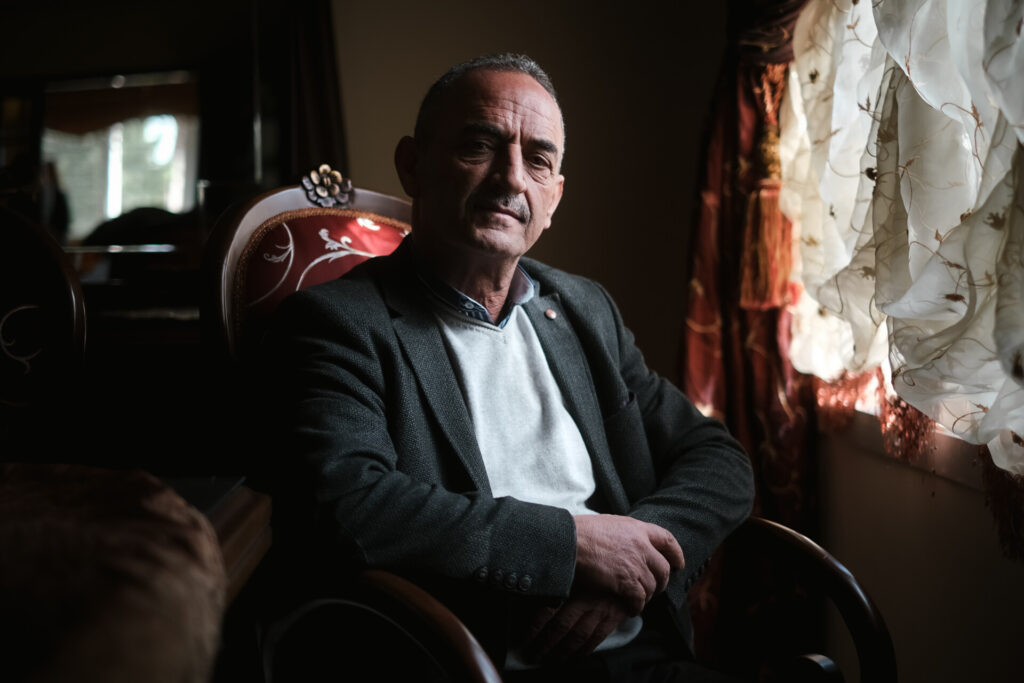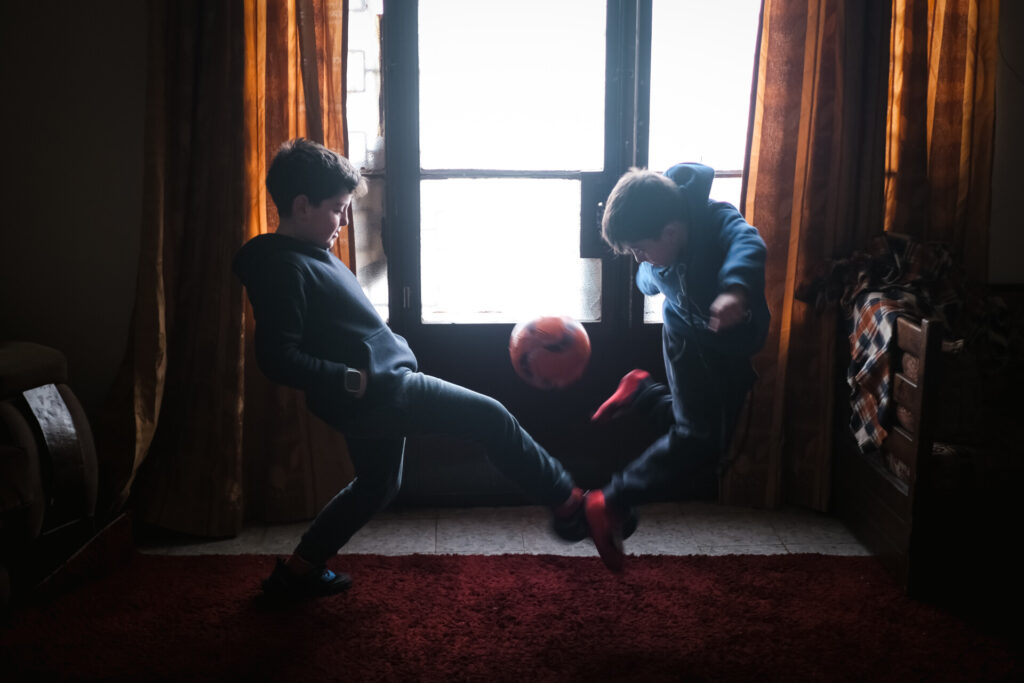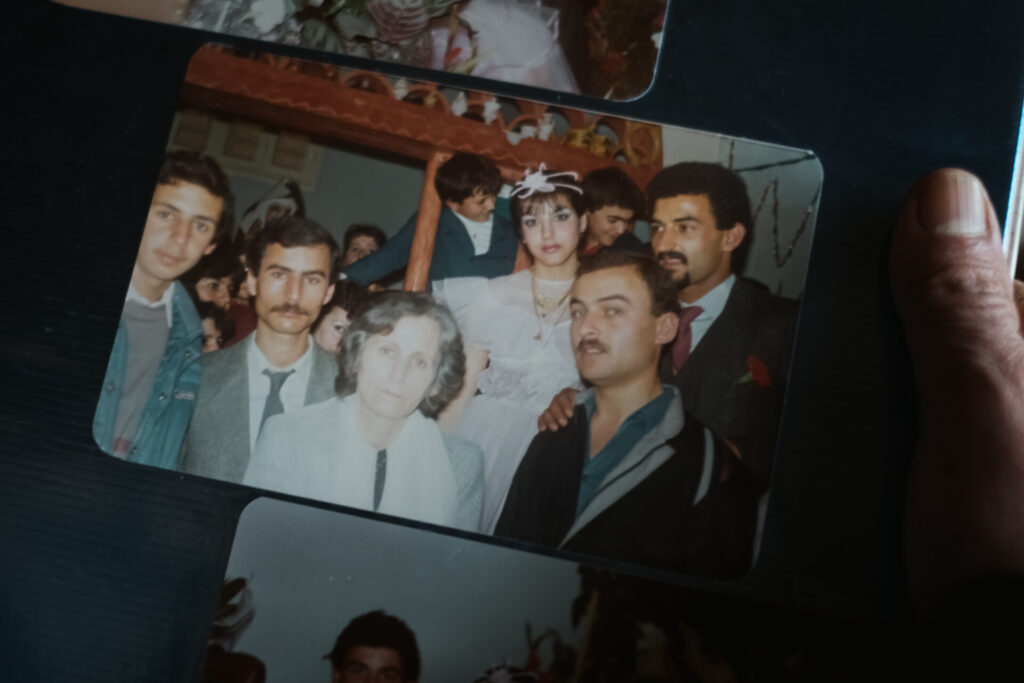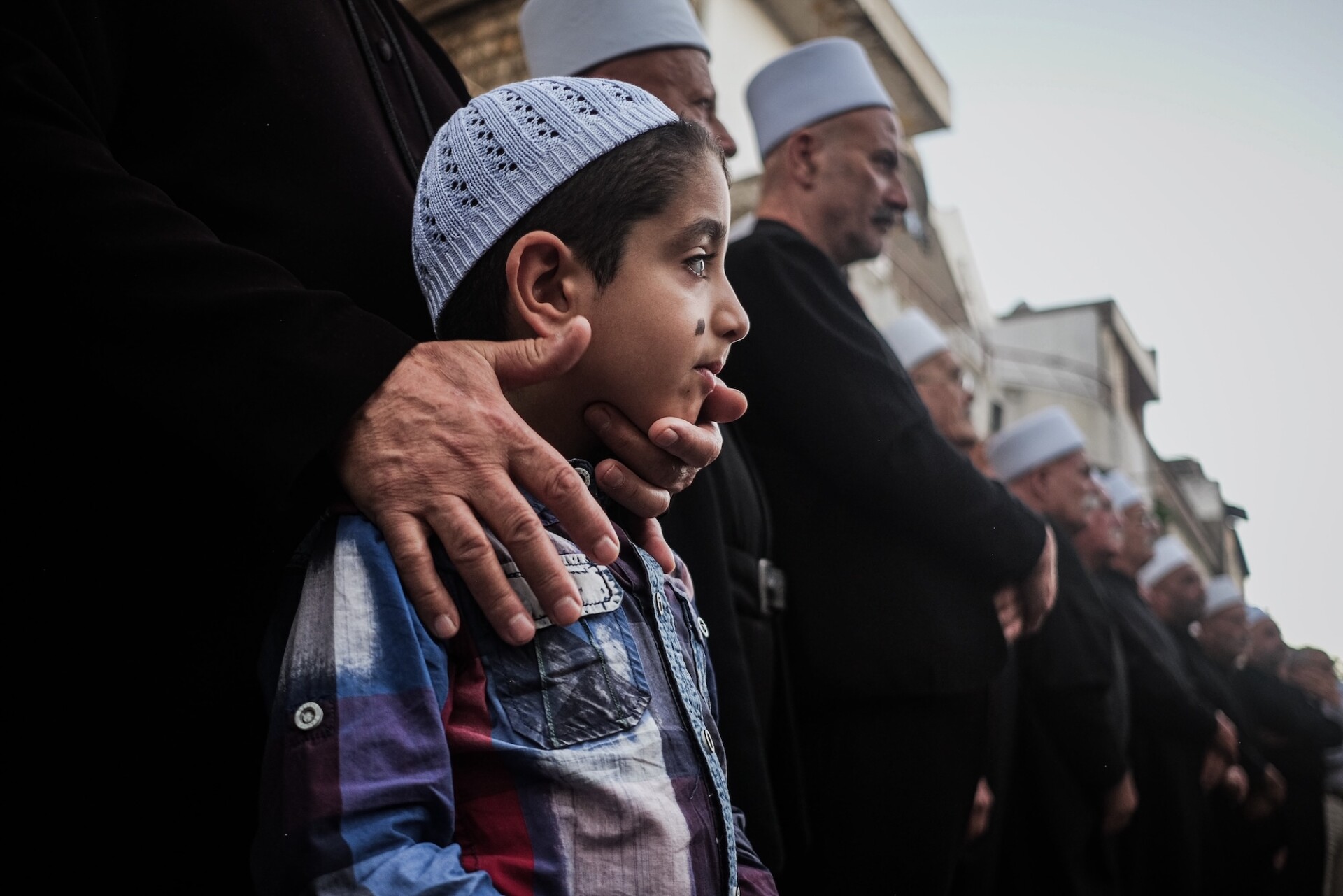It was Sept. 25, 1983, eight years into Lebanon’s deadly 15-year civil war and the height of the “Mountain War” between Christian fighters aligned with the right-wing Lebanese Forces and fighters from the majority-Druze Progressive Socialist Party (PSP). The two sides were battling for control of the mountains just southeast of Beirut, a diverse smattering of stone-arched villages overlooking the capital city, where Druze, Christians and Muslims usually lived in harmony.
Ayman Malaeb was four days shy of his 16th birthday. He was from Baysour, a Druze town of stepped alleyways and little olive-tree terraces snaking through the hills. It was surrounded by encroaching Lebanese Forces.
He was too young to join the fight. But his older brother Nadim still remembers that Ayman “used to help the guys by bringing them food and water,” despite his age. “There was barely civilian life there at the time,” the former PSP commander told me. “We were living in the highest stress possible.”
He also remembers the barrage of fire that killed Ayman. “I found his body afterward,” Nadim said. “My brother was martyred at noon.” He didn’t have much time to bury him. He and another of his brothers wrapped Ayman’s body in a simple blanket, interring it down the road in Baysour’s martyrs’ cemetery. “Between finding him and burying him, maybe 40 minutes had passed.”
Nadim was a commander; he had his posting back up on Baysour’s tallest hill to get to. “So we left.” Next came the wait. Nadim, just 23 years old when he buried his little brother, knew what would come next; he remembered going through it himself. A hint can be found on a plaque that was placed at the site of Ayman’s burial years after his death. On it, Ayman’s portrait, with boyish curls, is surrounded by photos of grown men with scruffy mustaches and disco-era sideburns. Some even bear the round white hats and knitted skullcaps of Druze religious sheikhs.
Numbering around a million people across Lebanon, Syria, Palestine, Jordan and a diaspora population, the Druze follow an offshoot of Islam that emerged in medieval Egypt and the Levant. To this day, they remain a bit of a spiritual outlier in the region: Faithful adherents believe in, among other things, the reincarnation of souls.
According to the faith, everyone is reincarnated. Druze are reborn as Druze, women as women, men as men — sometimes across international borders that divide disparate Druze communities from one another, other times simply in the next village. In Baysour, I was told of one woman born twice to the same mother. She still lives there today, in some ancient stone house. She is 95 and carries the memory of herself, a lost young girl who died too soon in a previous life.
Not everyone remembers. Most people, I’m told, are unaware of who they once were before they crossed the invisible curtain. It is a blissful ignorance. Those who remember their former lives do so because of the imprint of some traumatic death — in war or by car crash, murder, youth illness or freak accident — departing before one’s life story has rounded its arc. The trauma is said to leave its indelible mark on their memory. They take it with them to the next generation.
I’ll admit that when I first met Nadim Malaeb last year, I was after his story for personal reasons. Israel had been bombing Lebanon, where I live, for months, steadily building up a death toll that included women, men, children, civilians and fighters alike. At the same time there was a growing genocide in Gaza, where Israeli bombs struck hospitals, homes and displacement camps indiscriminately.
What followed all that violent death? I started dreaming about, of all things, earthquakes. I woke up thinking the room was crumbling around me. A contact in Baysour, a former civil war-era PSP fighter like Nadim, suggested I write about reincarnation. I agreed. That’s how I’d find myself sitting in Baysour with Nadim, now 64 and working as the town’s mayor.
It was Sept. 23, 2024, the same day Israel began to expand its deadly bombing campaign in Lebanon. About a million people would soon flee their homes in hard-hit south Lebanon and the southern Beirut suburbs within a matter of days. Israel’s bombs would rain down across much of the country, inflicting the worst wave of killing in decades. I’d find unrecognizable charred pieces of people at one bombed apartment block in Lebanon’s north and refugees stranded on city streets with nowhere to go. Sometimes the deep booms of the airstrikes reverberated across the hills to the town I’d moved to, north of Beirut, for safety. I knew almost every sound meant someone’s death. Probably multiple deaths. More than 4,000 people would be killed.
“It’s a heavy burden,” Nadim would later say of remembering.
Here’s what he remembers.
In 1959, with the civil war some 16 years into the future, Badih Daou was 33, a father of four from a tiny village near Baysour called Deir Koucheh. He owned a small ceramics factory in the village and a shop in Beirut’s Mar Elias neighborhood. Sales were modest.
The fine details are more dreamlike than vivid memory. One day, Badih set off driving a delivery truck with two other men. It crashed, killing all three of them instantly. A local man, Anis Malaeb, walked up to the overturned truck to check for survivors. Of course, there were none.
Not long after the incident, Anis’ pregnant wife gave birth to a baby boy in Baysour. They named him Nadim Malaeb.
A few years went by. Nadim-the-baby became Nadim-the-toddler, sounding out his first words. His baby Arabic soon hardened into strings of sentences. He began saying things — things that sounded strange coming from a toddler. He spoke about having died in that terrible truck accident, about “his” wife, children, ceramics business. He reeled off the names of Badih Daou’s family members back in Deir Koucheh.
The toddler boy apparently had no way of knowing who these people were or of carrying the memory of that horrific accident. After all, Nadim’s family members had never met Badih’s. When they took him the several miles south from Baysour to Deir Koucheh, and Nadim pointed out the route to Badih’s home, they knew he was remembering a past life. They met Badih’s children and wife, Suheila, whom Nadim told me he recognized immediately. “I said to Suheila, ‘It’s me, Badih.’ She started weeping.”
Children like Nadim are known among the Druze as the “natiqeen” (“those who speak”) of their past lives. Usually it happens at around 3 or 4 years old, when the child first begins to speak coherently. For Nadim, who says he isn’t particularly religious, the entire experience left him feeling confused. He didn’t quite understand the force of memory that guided him to Badih Daou’s wife and children, who somehow felt like his own. “I felt like a grown man, but stuck in the body of a child,” he told me.
“These memories feel like recalling a dream,” Nadim said at his house in Baysour. Behind him, breezes billowed a translucent white curtain. It is a dream that, long before his brother Ayman was killed on the battlefield, had made Nadim well acquainted with death.

On April 13, 1975, right-wing Christian fighters shot up a bus full of Palestinian refugees in a bustling neighborhood just south of Beirut. They killed 27 people and ignited a tinderbox of existing sectarian and class tensions into a full-blown civil war.
The bloodshed would last, off and on, until 1990. It would pit Lebanese against Palestinians against Syrians against Israelis, Christians against Muslims, even Christians against Christians. Druze were also in the mix, sometimes fighting alongside the mainly Shiite Muslim Amal Movement and Palestinian groups. Around 100,000 people would be killed and 17,000 more go missing, their black-and-white 1970s-style portraits still dotting some parts of the capital.
This month, Lebanon marks 50 years since the start of that brutal war. It is a war still seared in the living memory of those who survived it or, like Nadim, fought in it. Some people wear the memory proudly: Another former PSP fighter in Baysour, whom I met this past year, still has his rifles on display in his formal living room, latched to the wall in neat rows.
Yet, infamously, a collective amnesia still hangs over much of the war. Lebanon’s public schools don’t typically teach it, and there is no formalized state policy on how to commemorate it beyond a few street-level initiatives like Baysour’s martyrs’ cemetery or Beit Beirut, a museum housed in a formerly grand art deco mansion deliberately left scathed by the civil war’s bullet holes. To me, the jagged scars help tell the story of the place. Maybe they’re a warning. Would repairing the holes erase a vital part of it?
May Malaeb, a former wartime nurse from Baysour, lives in a quiet corner of the town past rows of clothing stores and little restaurants. There’s little evidence there now of the bloodshed that once riled this place. She was only 22 in 1983, at the height of the Mountain War, when she and her family fled further south into the Chouf mountains for safety.
There was little to occupy her time. So when a local hospital offered a training program for nurses to help treat the war wounded, she signed up. Soon, she’d land in the X-ray unit as a technician’s assistant.
“Our patients included both fighters and civilians,” May recalled, mostly fellow Druze from the surrounding Chouf region.

If the young Druze children who, like Nadim, begin speaking of their former lives are windows to rebirth, May’s time at the hospital showed her the other side of that invisible curtain — people wounded and dying before they departed for another life, in another body somewhere in the world. Once, after a bombing that hit a house where some dozen or so PSP fighters were resting, May helped treat the injured. “It was my first time helping in the emergency room. There was a guy whose intestines were visible, and two fighters were trying to hold them in place. I had to hold his arm steady so the doctor could insert an IV.” Another time, May was X-raying an injured fighter. His pulse was near zero, putting him at risk of organ damage and death. “He started saying, ‘I want my children,’” May told me. “Two or three days later, he died. Those were hard days.”
Where did their souls go?
May would go on to become a high school biology teacher at Baysour’s main public school, spending the remaining war years teaching teenage fighters from opposing factions. Some of them, she said, would attend class by day, and then “shoot at” Baysour by night. She remembers those days like a sort of fever dream.
One student was a 15-year-old PSP fighter named Sami Malaeb. “He was my brother’s friend, like my own little brother,” she said. “He was martyred.” According to May, the boy was reborn and went on to meet his old family from his previous life, still grieving the loss of their teenage son. “They say he suffered severe depression. He couldn’t forget his old life,” May told me. “There are many stories like this.”
Faisal, a man I met in Baysour, believes he was killed in his previous life by PSP friendly fire in Beirut. Reborn, he found a photo album on a visit, during his teenage years, to his former family’s home. In it were photographs of his own funeral. “I was disturbed by my [former] family grieving my loss,” he told me.
May recalled the story of a man whose brother was killed in battle in 1977, “his body vaporized, just pieces here and there.” The brother, a fellow fighter, simply carried the bits away. He’d become the body part carrier of his battalion as the war dragged on, taking on the task of burying the pieces of his fallen colleagues but, like May, never seeing the other side of the curtain. “He went on to get married and have kids, but he is still hurt by this experience. He just sits there, silent,” she said. “We call him a living martyr.”
And though the haze of dreamlike stories from reincarnation can warn people of the horrors of war, it’s not often so simple, according to Malek Rasamny, a documentary filmmaker and anthropologist. He’s spent the past several years interviewing dozens of people with reincarnation stories linked to the civil war, for his upcoming book.
“Reincarnation creates a space for certain things in the community to be discussed that normally wouldn’t be, like violent death, loss, betrayal, abandonment,” Rasamny explained, “The classic idea in anthropology is that reincarnation serves two functions: It helps people deal with death, and it brings people closer together,” as they are mourned and reborn in the same communities.
“It does sometimes, but oftentimes it doesn’t,” Rasamny said.” Sometimes, it ends up creating more problems … old wounds are opened up. It can do very different things.”
Perhaps it has no function at all. “Does love serve a function? Do dreams serve a function? It’s a way of interpreting a reality, a way of listening to children. It’s a lens through which [people] see things.”
“I’m one of the people who doesn’t want to remember,” May told me at her home in Baysour. “I think back to the worst days of sitting in the bomb shelter, hearing the booms outside, holding my hands over my ears like this.” She covered her ears for a moment, remembering. I let her. I thought back to the day of one deadly street clash below my house in Beirut four years ago — the heavy thumps of RPGs followed by the neighbors’ children screaming, my partner and I sheltered in the hallway, stuck in place. I remembered covering my ears, too. “I don’t want anyone else to ever feel that way,” May said.
Sometimes, in a way, remembering is happy: the joy of meeting a long-lost brother from a previous life or finding an old beloved motorcycle, a pet or a stash of money and jewelry hidden away and left to sit beneath a mattress somewhere, undisturbed until its dead owner returns anew.
“I feel most connected to the objects that come from handiwork, like sewing and cooking. You can feel the past of the person who once used it,” Majda Awar said. She and her husband Amin Basheer live on a hill at the edge of Baysour. There, the couple own a three-story apartment block that they’ve converted into something of a homespun museum: room after room of curated bits and pieces of everyday Lebanese items from the past century or so that Amin gathered. They call it “Mathaf Amin” — Amin’s Museum.
I had been searching for someplace, maybe a local antique shop, where we could find old objects owned by long-dead local residents. Maybe, I thought, I could feel something of the past lives they lived, the things that filled their days and made up the world they knew — or at least get photos for this article.
What I found was a treasure trove. In one side room were box after box of antique sewing tools. In another, dozens of ancient radio sets; a long-disused barbershop chair surrounded by impossibly old shaving kits; a glass display case of shrapnel Amin found across Baysour — some during the civil war, when he was a schoolkid dodging snipers, another neat pile from an Israeli bombing that struck close by just in the past six months.
Majda’s favorite item is a 6-foot-tall wooden spoon, once used by the women of a nearby Druze village to stir giant vats of dibs rumman (pomegranate molasses).
“Look,” she pointed to the handle. “You can see where all their hands wore down at the wood.” It was smooth, like timeworn stairs of an ancient castle. Little shallow grooves dip into the wood where long-gone hands once gripped it.
They were like the little plastic bag of unfinished crochet pieces one woman down the road showed me the previous month; her 12-year-old son, Jneid, died in a car crash back in 2020 before he could finish them. Some are still in neat rows of colorful yarn; others are unraveling with the years.

“We’re living in the hope of him coming back to us someday and saying, ‘It’s me, Jneid,’” his adult sister, Diyala, told me. She, her brother Ayman and sister Khuloud all have tattoos commemorating their lost brother. A photo of him hangs in the living room, beyond some sand and seashells he gathered at the beach just hours before the fatal crash.
They figure it’s been long enough now — if Jneid is out there, somewhere, his new self is old enough to begin remembering. Maybe he’ll find them.
On the wall in one corner of Amin’s and Majda’s museum nearby are photos of Baysour sheikhs long past, their black-and-white beards and outfits captured by some forgotten photographer a century ago. In another photo, in a room full of vintage radios and TV sets, is Amin’s grandmother, who passed decades ago, as a young woman.
But when I asked, Amin forgot his grandmother’s name. It’s been too long. “In Lebanon lately, everyone is having trouble remembering things,” Majda said.
“Memories cannot be preserved like nonbiodegradable material, like a statue, which will stand no matter what,” Rasamny, the anthropologist, told me. “I’d compare reincarnation to organic material. It doesn’t disintegrate like amnesia, but it allows the memories to slowly get absorbed back into the community as the person grows up.”
As the young Nadim grew older, he kept in close touch with his former self’s wife and children, who came to feel like his own. The civil war years came. Nadim was a young man by then. He became a fighter, and several years after that, he married his wife. Soheila, his wife from his previous life, attended. In a photo album Nadim showed me of the reception, she looked frail and elderly, the flash of the camera too harsh on her face, almost like a ghost.
One day, a man from Jaramana — a bustling suburb of Damascus with a large population of Druze — would contact him by phone. His name is Wissam Obeid. He’s one of the natiqeen and claims to be Ayman, the 15-year-old brother Nadim lost to war all those years ago. They keep in touch, through relatives, but Nadim seemed to shrug off the encounter — it’s ancient history.
His sense of himself as Badih Daou, the dead ceramicist, also fades as his Nadim self rounds the milestones of life. He had children and later, grandchildren. He built a beautiful house in a tree-lined corner of Baysour, overlooking a garden.

I left Nadim’s home and headed for the martyrs’ cemetery, where I later found that blurry black-and-white photo of a curly-haired young Ayman on the fading plaque.
At the cemetery, too, I found Diyala — Jneid’s grieving sister.
Somewhere beneath the wildflowers near her was Ayman’s 15-year-old body, buried in a rush some 42 years ago, amid the bombs. I couldn’t find the exact location. In one stone tomb was the body of young Jneid, left to its mysteries since that day at the beach in 2020.
Diyala whispered tender prayers to him a few paces past earshot, behind a blur of tall dry grass.
Sign up to our mailing list to receive our stories in your inbox.




